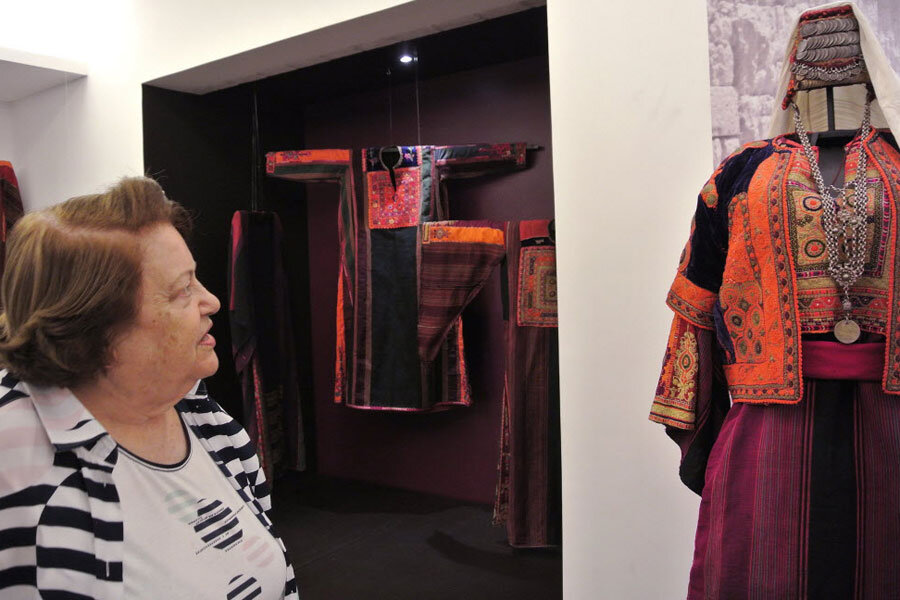Museum showcases traditional Arab dresses, and stories of female creators
Loading...
| Amman, Jordan
Growing up on the West Bank of the Jordan River in the 1940s, Widad Kawar would pass by Palestinian women sitting on balconies and under trees embroidering the intricate panels of traditional dresses.
The patterns and colors were unique to each region. The skill required for the tiny stitches was considered a test of how a potential bride would fare at housekeeping.
“This embroidery kept the generations together,” says Ms. Kawar, who over decades has amassed the world’s largest collection of Arab heritage dresses.
“Everybody was needed – particularly the grandmothers. They would teach the young.”
Here in Amman, Kawar recently opened a museum – named Tiraz, from the old Arabic word for embroidery – that showcases some of the 2,000 pieces in her collection of dresses, textiles, and jewelry.
She says she wants to keep the dress patterns alive as well as reintroduce Jordanians and Palestinians to their heritage.
In a region where women’s lives are often invisible and their painstaking handiwork fragile, Kawar has undertaken to bring the names of prominent seamstresses to light and to preserve the pieces that embodied their hopes and dreams.
“I want people who see [the dresses] to think of something new to develop with these designs – to carve them in wood, or use them in modern dresses,” she says. “I don’t want them to be just hanging in a museum.
The seven-month old museum, located in the quiet Jabal Amman district, is a far cry from the normal dusty galleries of folkloric objects. Vibrantly-colored dresses pop against the museum’s modern white walls. Eye-catching exhibits tell the stories of the stitches and the women behind them.
Teenage girls spent hundreds of hours embroidering the dresses and cushion covers for their trousseaus. When a village woman died, she was normally buried in her best dress.
From beauty to valuable history
For those who know how to read them, the patterns and colors are a language of their own – the blue embroidery on black signifying a widow, the pink and red squares added on to show she had re-married.
In more than 60 years of gathering the pieces and listening to the women’s stories, Kawar has become a social historian as well as a collector.
“My aim is to capture the complexity of Palestinian society and the bitter-sweet memories of the women who owned the dresses,” she writes in her book “Threads of Identity.” “While most of their stories are spun around trauma, loss and destruction, they also contain golden threads of love, humor, harmony and personal triumphs.”
With war and the creation of the state of Israel in 1948, hundreds of thousands of Palestinians were forced into refugee camps where they had no money for fabric and no time to sew. Kawar, from a prominent Palestinian family, says she began collecting dresses as a way to preserve that heritage.
“I wanted to keep something of the beauty,” she says. “I picked up a few pieces of embroidery, and then it developed to finding costumes of every area and then learning the stories of these costumes. I feel now that the information I gathered is even more valuable than the pieces, because it’s history.”
Historical events' impact on fashion
The museum’s current exhibit, Golden Threads of Bethlehem, highlights the biblical city’s rich and ornate style of embroidery in the late 19th century until 1948. Silk and golden threads along with small crosses were densely embroidered onto panels of the dresses.
The most elaborate – intertwined vines, flowers, birds and geometric patterns – were placed on the back of the dress where they could be safely admired by passers-by.
For married women the dresses, often accompanied by gold-embroidered velvet jackets for those who could afford it, were worn with a small hat covered in gold and silver coins – the dowry given by the groom at the wedding.
Kawar also documents the changes wrought by history to traditional fashion. The oldest piece is a linen dress from the 1880s. After the 1967 war and Israel’s occupation of the West Bank, many ties were severed with the Arab world and silk from Syria was no longer available. Later dresses were made with synthetic fabric and cotton threads.
Her collection includes dresses embroidered with the Palestinian flag– a tradition that began during the uprising against Israeli occupation in the late 1980s when the flag was banned.
“Women began going to the protests,” she says. “Soldiers would take away the flags, but they couldn’t take the dresses they were wearing.”
Vanishing Arab heritage
The collection spans the rapidly vanishing heritage of much of the Arab world. Rows of embroidered dresses divided by country line the storage racks, including what is believed to be the world’s largest collection of traditional Syrian dresses.
At a recent exhibit, Iraqi Treasures, Iraqi textile expert Layla Pio displayed gossamer silk dresses embroidered with gold and silver threads and silver accessories used in public baths. Much of the finest work came from Mosul.
In November, the museum will display an exhibit of amulets from Jordan, Palestine, Syria, Yemen and Oman – many of them silver etched with drawings and incantations to keep the wearer safe or to find love. Some have blue stones, to ward off the evil eye.
“The Bedouin use shells and stones,” says Kawar. “Almost every culture has these.”







